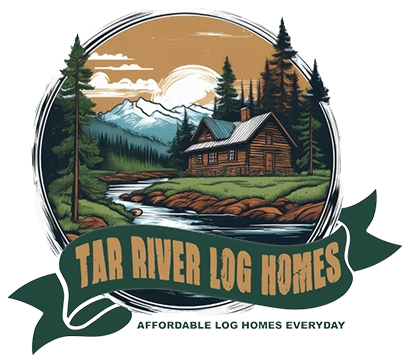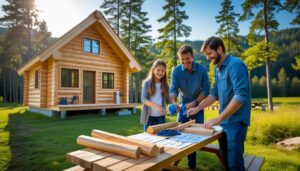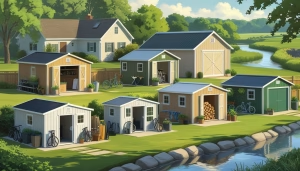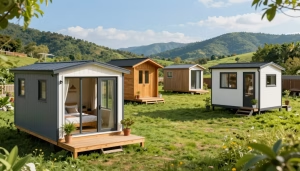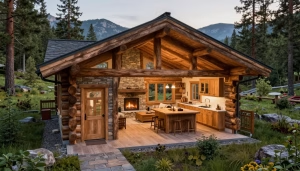Log home kits give families an affordable way to build a house that feels solid, warm, and personal. Instead of chasing down parts, everything comes bundled—logs, plans, hardware—ready to go.
That means fewer headaches and a budget you can actually stick to. Families save time, cut costs, and avoid the guesswork of piecing together a custom build from scratch.
At Tar River Log Homes, pricing is clear and simple. No hidden fees—just quality materials that fit family life without breaking the bank.
This guide explains what log home kits include and how they differ from traditional builds. Keep reading and also learn what families should know about costs, styles, and long-term care.
What Are Log Home Kits for Families?
Log home kits for families are meant to make building a log home easier, way more affordable, and less of a time sink. Everything you need arrives in one package. These kits let you control how your home looks and feels, all while keeping costs below what you’d pay with a traditional build.
Definition and Overview
A log home kit is a ready-made set of materials and instructions to build a log house. It covers all the main building parts—logs, doors, windows, and hardware. The pieces are designed to fit together, so you’re not left guessing or running to the store for missing parts.
It’s a great route for families who want a sturdy, natural home but need to keep spending in check. You can pick from different sizes and styles, so finding a plan that suits your family’s needs is much simpler.
How Log Home Kits Differ from Traditional Builds
Traditional home building? That usually means juggling several contractors and buying materials piecemeal. It’s slow, expensive, and honestly, a bit of a headache. Log home kits cut through the mess. Everything’s organized and delivered in one shot, so you dodge extra costs and confusion.
You also avoid those annoying delays waiting for materials. Most kits come with detailed guides, so you can do a lot yourself or with family. This hands-on approach often saves big on labor compared to hiring a full crew.
Key Components Included
A typical kit will have:
- Pre-cut logs: Usually kiln-dried to help prevent warping.
- Blueprints and instructions: Step-by-step so you don’t get lost.
- Windows and doors: Sized to fit your plan, shipped with the rest.
- Roof trusses and hardware: Nails, screws, fasteners—all the essentials.
- Additional materials: Things like insulation, siding, maybe porch pieces, depending on the package.
Kits should include quality wood and clear, fair pricing. You pick the model, and most of the hard work is done before you even start.
Benefits of Log Home Kits for Families
Log home kits make building your own place more doable, affordable, and personal for families. They’re flexible, let you save money, and help you live smarter, energy-wise. Plenty of folks go this route because it lets them shape a home that fits their family’s lifestyle, not the other way around.
Affordability and Cost Savings
Building with a log home kit means you skip a lot of extra spending. Materials come straight to you, so you’re not paying markups or wasting time. That way, you can stick to a budget without sacrificing quality.
Tar River Log Homes prices logs by the linear foot, so you only get what you need—no wasted cash. And if you find a better deal, there’s a 105% price guarantee. That’s some peace of mind.
You’ll save on labor, too, by doing parts of the build yourself or with family. The kits include clear instructions, so you don’t have to be a pro to get it done, and you won’t need to shell out for a full crew.
Family-Friendly Customization Options
A kit lets you shape your log home to fit your family’s quirks and needs. Choose from a bunch of floor plans or even ask for custom tweaks. You’re in control of bedrooms, living spaces, and extras like playrooms or home offices.
A lot of kits include options for outdoor spaces, which is great for family hangouts or letting the kids burn off energy. You pick the style and finishes, so your place feels as cozy or open as you want.
Choose flexible kits with quality materials so the design fits your family. You get to avoid cookie-cutter templates that don’t fit your life.
Energy Efficiency and Eco-Friendliness
Log homes are naturally good at keeping in the heat (or keeping it out), thanks to thick wood walls. That means you’ll stay cooler in summer, warmer in winter, and save on energy bills. Prefer kits that use kiln-dried Eastern White Pine logs. It’s tough, dry, and less likely to shrink or warp, so your place stays tight.
Logs are a greener choice than a lot of other materials. Wood is renewable and stores carbon, so you’re doing the planet a favor, too. Smart design touches in the kits—like tight seals and good window placement—make your home even more efficient and comfortable, year-round.
Popular Log Home Kit Styles for Families
When you’re picking a log home kit, you’ll see styles for every taste and family setup. Some are all about classic charm, others blend old-school looks with new features. There are even designs that mix rustic style with modern touches, so you can really make it yours.
Traditional Log Cabin Designs
Traditional log cabins use chunky, round logs and keep things straightforward. Expect steep roofs, big front porches, and simple floor plans.
These homes are perfect if you love timeless looks and don’t want a complicated build. Open living spaces and easy-care materials are a win for families who like things cozy and relaxed.
Key benefits:
- Classic, homey appearance
- Solid structure
- Budget-friendly choices
You can expand or tweak these cabins with ease. Many plans use Eastern White Pine for strength and a warm tone.
Contemporary Family Log Homes
Contemporary log homes bring in big windows, open spaces, and clean lines. They flood the house with sunlight and keep everything feeling spacious, but you still get the beauty of real wood.
If your family likes modern living but doesn’t want to lose the cabin feel, this style’s a good pick. Designs often have smart features like open kitchens and flexible rooms for whatever life throws at you.
Highlights for families:
- Bright, open interiors
- Mixes wood with sleek finishes
- Layouts that adapt as your family grows
Your kit can come with step-by-step plans so you can build exactly what works for you.
Rustic Modern Variations
Rustic modern styles blend rough-cut wood with simple, modern shapes. Think natural materials with a few smooth edges, maybe some metal or glass thrown in.
If you want a place that feels warm and inviting but is still current, these are worth a look. They’re great for families who want a bit of tradition and a bit of now.
Points to consider:
- Unique mix of textures
- Often feature energy-saving upgrades
- Perfect for hobby rooms or studios
Look for affordable options that don’t skimp on quality, so your rustic modern home is both stylish and built to last.
Choosing the Right Log Home Kit
Picking the right kit means thinking about your family’s needs, space, and what materials will last. You want something that’s a good deal, stands up to the years, and has enough room for everyone. Getting these details right helps your log home feel like, well, home.
Essential Factors to Consider
When you’re choosing a log home kit, quality and cost should be front of your mind. Look for kits with clear pricing and no sneaky fees. Think about how much help you’ll need.
Some kits come with step-by-step instructions and pre-cut logs, which is great if you’re not a seasoned builder. Make sure the kit matches your skills, or be ready to call in a pro. Style and design matter, too. You want a house that fits your vibe and life, but also your budget and lot.
Sizing and Space Planning for Families
The size of your kit should match how your family lives—not just now, but down the road. Plan for enough bedrooms, bathrooms, and living areas so everyone’s comfortable. Think about how you use space—maybe you need a spot for guests, an office, or a playroom.
Open floor plans are popular since they make small spaces feel big. But hey, not every family wants everything wide open—sometimes you just need a door to close. Look for kits with flexible layouts so you can shape the space your way.
Don’t forget about storage. Good built-ins and closets keep clutter at bay and make life easier.
Material Types and Durability
Log home kits come in different woods, and that affects how long your house will last. Eastern white pine is a favorite—it’s sturdy, easy to work with, and stands up to pests. Many kits use kiln-dried Eastern White Pine logs to limit shrinkage and warping.
Ask about how the logs are finished and treated. That’s what keeps weather and bugs from messing up your hard work. Some kits include logs that are already prepped for the long haul, saving you time and hassle.
Pick a wood that suits your climate. If you’re in a wet or cold spot, look for logs that can handle those conditions without giving up strength.
Building and Assembly Process
Building your own log home kit takes some planning, a bit of elbow grease, and maybe a call to a pro. You’ll need to sort out permits, organize your parts and tools, and then either jump in yourself or get help where you need it.
Preparation and Permitting
Before you get started, check your local building codes and zoning rules. You’ll almost always need a permit to make sure your home’s up to snuff. Call your town or county office to see what paperwork they want.
Get your building site cleared and make sure the foundation’s solid. A good foundation keeps trouble away later. It might be smart to hire a surveyor or do a soil test, just to be safe.
Getting plans approved can take a few weeks, so get your documents together early. Being prepped makes the whole process smoother.
Step-by-Step Assembly
Start your log home kit on a solid foundation, following the instructions. Usually, you’ll lay the sill logs first—they’re the base. Then, stack the wall logs, matching up notches and fasteners.
Each log is numbered or marked, so it’s tough to mess up. After the walls, you’ll put in door and window frames. Keep things level and square as you go.
Next, add the roof beams and rafters, then the sheathing and shingles or metal. Seal up any gaps for insulation and to keep out the weather.
You’ll want a hammer, drill, level, and ladder handy. If your family’s pitching in, split up jobs by what everyone’s good at.
Working with Professional Builders
If you’d rather not go it alone, hiring a builder who knows log cabins can save you time and headaches. Pros know all the tricks—tight joins, insulation, finishes.
Experienced log-home builders can assist or oversee the build when needed. Buy your kit, and they can assist or oversee the build. That way, you get top materials with expert assembly.
If you’re new to construction or want things to move quickly, bringing in a builder is a good call. Always check their references and experience with log homes before signing anything.
Customization and Upgrades
Your home should fit your family—not the other way around. Customizing means adding features that make life easier, stretching out spaces for comfort, and picking smart upgrades to keep your place efficient and up-to-date.
Adding Family-Friendly Features
With a log home kit, you can add things like extra bedrooms, playrooms, or a mudroom to keep the mess in check. Consider wider hallways and doors for easy movement, especially for little kids or older relatives.
Storage really matters. Built-in shelves and closets help keep toys, tools, and clothes organized. Energy-efficient windows are a must—they keep you warm in winter, cool in summer, and save you money.
Expanding Living Spaces
If your family’s growing or you just want more space to spread out, expanding is the way to go. Maybe a bigger kitchen with an island for family meals, or a covered porch for outdoor hangouts. More living space means less crowding and a comfier home.
Open-plan designs work great in log homes, making rooms feel bright and roomy. You could also finish a basement or add a loft for extra bedrooms or a quiet spot to read. These upgrades give your family space to grow, without losing that cozy cabin feel.
Options for Smart Home Integration
Making your log home smart just makes sense—it bumps up safety, comfort, and even cuts your energy bills. Toss in a smart thermostat that tweaks the temp on its own, or lighting that shuts off when you leave the room. It’s less hassle, more savings, and honestly, it feels good to let tech handle the little stuff.
Security? That’s covered too. Smart locks and cameras mean you’re not stressing over lost keys or what’s happening when you’re away. Some folks even add smart kitchen appliances—because why not? Some kits can handle these upgrades, so you’re not stuck with yesterday’s tech.
Cost Breakdown and Financing
Let’s talk numbers. Building a log home kit isn’t just about the sticker price. There are layers—materials, labor, site work, and those sneaky extras that pop up along the way. If you know what to expect, you’re less likely to get blindsided.
Estimating Total Costs
The total? It’s the kit price plus stuff like the foundation, shipping, permits, and whatever else pops up. Most kits start you off with the basics: logs, windows, doors, and hardware.
But you’ll also need to think about:
- Site prep and foundation work
- Labor, unless you’re doing it yourself
- Plumbing, wiring, the works
- Interior finishes—floors, cabinets, all that jazz
The kits usually cover the shell, but stuff like insulation or roofing? Sometimes extra. A good rule: pad your budget by 15-20% for the things you didn’t see coming.
Financing Options for Families
Financing a log home kit isn’t one-size-fits-all. Personal loans are out there, but the rates can sting. Construction loans dole out cash as you build, but you’ll need solid credit.
Some families try FHA loans or other government-backed deals with lower down payments. If you’re going the DIY route, be ready to show lenders you know what you’re doing—or bring a co-signer.
Financing Paths for Rural Builds
Rural family builds may qualify for USDA Single-Close construction-to-permanent loans, combining build and mortgage into one closing in eligible areas. Check lender eligibility early.
Saving on Construction Expenses
Cutting costs? Stick with simple floor plans, and jump in where you can—site prep, painting, whatever fits your skills. Rope in family and friends if they’re game. Buying direct from a supplier can reduce markups and delivery waste.
Standard log sizes (instead of custom) keep prices down, too. A checklist is your friend—track every expense so you’re not surprised later. Picking up local materials for stuff like concrete or hardware can shave off delivery fees.
Safety and Maintenance Tips
Keeping your log home safe and in shape isn’t rocket science, but it does take some attention. A bit of planning goes a long way—catching little problems before they blow up.
Childproofing Log Homes
Log homes have quirks—exposed beams, chunky wood, corners everywhere. Kids see a climbing gym. Make sure railings on stairs and porches are sturdy. Pop corner guards on sharp edges where little ones crawl or bump around.
Lock up tools, nails, and any wood treatments. Logs can splinter, so run your hand over surfaces now and then, sanding down rough patches to keep scrapes at bay. Install window locks and latches to keep curious hands safe.
Fireplaces and stoves? Always use screens. Log walls hold heat differently, and it’s just safer with kids running around.
Routine Maintenance for Longevity
Upkeep keeps your log home strong—no shortcuts here. Check the roof and gutters twice a year, especially after storms, so water doesn’t sneak in. Clean and reseal the logs every 3-5 years to fight off weather and bugs.
Look for gaps or cracks in the logs and chinking. Seal them up—keeps drafts and pests out. Watch the foundation and drainage. Too much moisture and you’ll be dealing with rot.
Jot down your maintenance tasks and set reminders. Even simple stuff, like trimming bushes and clearing away debris, helps a ton.
Handling Common Repairs
Small fixes matter. Tighten up loose boards or railings as soon as you spot them—no one wants a surprise fall. If you see cracks in the logs, fill them with log-friendly caulk or epoxy before water gets in.
Keep an eye out for insect trouble—tiny holes or sawdust piles are a giveaway. Treat it early with the right products. When you need to swap out chinking or trim, stick with materials that match your home.
If a repair feels out of your depth, call in a pro—especially for electrical stuff. Having a repair kit with nails, wood filler, and sealant on hand makes quick fixes painless. Your home deserves a little TLC.
Inspirational Family Log Home Stories
Picture a family of four chasing a cozy home without blowing the budget. They got a basic kit, followed the instructions, and spent weekends building their dream cabin. They learned as they went, saved a bunch, and ended up with a place that felt totally theirs.
Another family went custom. They wanted a bigger playroom, a porch for those lazy evenings, and a space that fit their lives. Their home turned into the go-to spot for family gatherings, and every log seemed to hold a story.
The materials stood up to the seasons, so they weren’t constantly patching things. Then there’s the couple who built a second home near the mountains. A clear price guarantee gave them peace of mind, so they could focus on building instead of worrying about hidden costs.
They knew they weren’t getting gouged, so they could focus on building their future instead of sweating hidden fees.
These stories? They’re proof that regular folks can build real homes and actually love the process. You don’t need a fancy showroom or a fat wallet—just a solid plan and a little grit.
Choosing The Right Log Home Kit For Your Family
Family builds work best when the scope, budget, and schedule are crystal clear. Confirm what the kit includes, match moisture control to your climate, and plan a light seasonal maintenance routine to protect your investment.
If you’re ready to run the numbers, Tar River Log Homes keeps quotes simple and family-friendly.
Ready to price your build? Request a line-item kit quote and start planning today.
Frequently Asked Questions
Finding the right log home kit means weighing cost, quality, and where you’ll build. If you know what matters, you’ll make smarter choices—no surprises.
What factors should I consider when comparing prices of log home kits for families?
Check what’s actually in the kit—log quality, blueprints, extras. Don’t forget to factor in shipping and any sneaky fees. Compare the whole package, not just the headline price.
Where can I find log home kits for families in my area?
Start online—lots of companies ship nationwide. Local builders or dealers might have options too. Tar River Log Homes ships direct, which saves you the middleman markup.
How much does it usually cost to build a small cabin from a kit?
A small cabin? Usually $30,000 to $60,000 for materials. The final price depends on size, custom tweaks, and whether you hire help. Kits cut costs compared to custom builds.
Which companies provide the best log home kits suitable for family living?
Look for companies that focus on solid materials and honest pricing. Tar River Log Homes has a good rep for quality logs and straightforward deals. Read reviews and ask about warranties and support.
Can I save money by building a log cabin with a kit rather than from scratch?
Absolutely. Kits bundle everything you need, so you’re not piecing it together or wasting money. You get plans and instructions, too—way fewer headaches and costly mistakes.
What are the advantages of purchasing a log home kit rather than building a custom log home?
When you go with a kit, you’re basically handed clear plans and the materials you need—so you’re not left scratching your head or blowing your budget. Custom builds? They can drag on and, honestly, tend to spring extra costs on you when you least expect them.
Kits let you shape the design within certain boundaries, but you know upfront what you’re spending and how long it’ll take. That kind of predictability is hard to beat.

